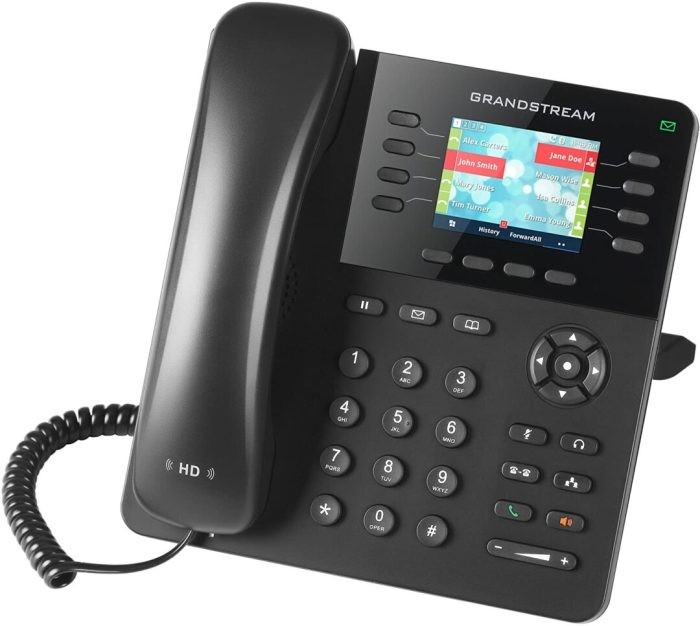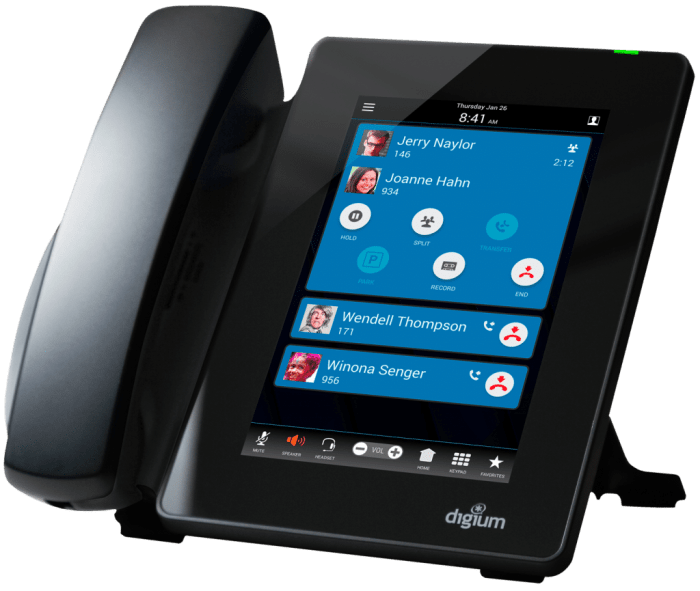
Best Business Phone Systems: A Guide to Modern Communication
Best business phone systems are more than just tools for making calls; they’re the foundation for efficient communication, collaboration, and customer service. In today’s digital landscape, a robust phone system is essential for businesses of all sizes to thrive. From simple call forwarding to advanced features like video conferencing and CRM integration, the right system can streamline operations, boost productivity, and enhance the overall customer experience.
This guide will explore the different types of business phone systems available, highlight key features to consider, and provide practical advice on choosing, implementing, and optimizing the right system for your specific needs. Whether you’re a startup or a large enterprise, understanding the benefits and complexities of business phone systems is crucial for success.
Understanding Business Phone Systems

In today’s competitive business landscape, having a reliable and efficient communication system is paramount to success. Business phone systems, also known as Unified Communications (UC) solutions, are essential tools that enable businesses to streamline their communication processes, enhance productivity, and foster stronger customer relationships.
Core Features of a Business Phone System
Business phone systems offer a wide range of features designed to meet the specific needs of various businesses. Some common features include:
- Auto Attendant:This feature automatically answers incoming calls and routes them to the appropriate department or individual based on pre-programmed menus. This helps businesses provide a professional and efficient first impression to callers.
- Call Forwarding:This allows employees to redirect calls to their mobile phones or other devices, ensuring they can stay connected even when they are away from their desks. This flexibility helps businesses maintain uninterrupted communication and improve employee productivity.
- Call Hold:This feature allows callers to be placed on hold while the recipient retrieves information or attends to another task. It helps avoid call drops and ensures a seamless communication experience for both parties.
- Call Waiting:This feature notifies a recipient of an incoming call while they are already on another call. This allows them to decide whether to answer the new call or put the current call on hold. This feature helps businesses avoid missed calls and ensures timely responses.
- Conference Calling:This feature enables multiple participants to join a call simultaneously, facilitating collaborative discussions and meetings. This is particularly useful for businesses that require frequent communication with multiple stakeholders.
- Voicemail:This feature allows callers to leave messages when the recipient is unavailable. Businesses can customize voicemail greetings to reflect their brand identity and ensure a professional experience for callers.
- Call Recording:This feature allows businesses to record calls for training purposes, quality assurance, or legal documentation. This can be helpful for resolving disputes or ensuring compliance with industry regulations.
- Unified Messaging:This feature integrates voicemails, faxes, and emails into a single platform, making it easier for employees to access and manage their messages. This helps businesses avoid information silos and improve communication efficiency.
- Video Conferencing:This feature enables businesses to conduct virtual meetings and presentations, fostering collaboration and reducing travel costs. This is particularly valuable for businesses with remote teams or international operations.
Benefits of Implementing a Business Phone System
Implementing a business phone system can bring numerous benefits to businesses of all sizes. These benefits include:
- Improved Communication Efficiency:Business phone systems streamline communication processes by providing features such as auto attendants, call forwarding, and unified messaging. This helps businesses respond to customer inquiries more efficiently and improve overall productivity.
- Enhanced Customer Service:By offering features like call waiting, hold music, and voicemail, businesses can provide a more professional and personalized customer service experience. This can lead to increased customer satisfaction and loyalty.
- Increased Productivity:Business phone systems enable employees to stay connected from anywhere, improving their ability to respond to urgent calls and inquiries. This can lead to increased productivity and efficiency.
- Cost Savings:Business phone systems can help businesses save money on traditional phone lines and long-distance calls. They also offer features that can reduce the need for travel, further reducing costs.
- Scalability and Flexibility:Business phone systems are highly scalable and flexible, allowing businesses to adjust their communication needs as they grow. This ensures that businesses can adapt to changing market conditions and maintain efficient communication.
Real-World Examples of Businesses Successfully Using Phone Systems
- Small Business Example:A small bakery implemented a cloud-based phone system to manage its growing customer base. The system’s auto attendant feature allowed customers to easily place orders and receive information about the bakery’s offerings. The bakery also benefited from call forwarding, which enabled employees to stay connected even when they were out on delivery runs.
As a result, the bakery experienced improved customer service, increased sales, and a more efficient workflow.
- Medium Business Example:A medium-sized law firm implemented a business phone system to enhance its communication with clients and streamline internal operations. The firm’s system provided features such as conference calling, which facilitated team meetings and client consultations. The system’s unified messaging feature allowed lawyers to access voicemails, faxes, and emails from a single platform, improving communication efficiency.
Finding the best business phone system for your salon can be a challenge, but it’s essential for smooth operations and client communication. You might be surprised to find inspiration in unexpected places, like the hairdressers journal heard purple shampoo challenge , which showcases the power of community and shared knowledge.
Just as hairdressers learn from each other, a reliable phone system can connect your team and clients, making your salon a hub of creativity and communication.
The firm reported increased productivity, reduced communication errors, and improved client satisfaction.
- Large Business Example:A large corporation implemented a unified communications platform to connect its global workforce. The platform’s video conferencing capabilities enabled employees to collaborate on projects and conduct meetings remotely. The corporation also benefited from the platform’s instant messaging and file sharing features, which fostered a more connected and collaborative work environment.
The corporation reported improved communication efficiency, reduced travel costs, and increased employee productivity.
Types of Business Phone Systems
Choosing the right business phone system is crucial for effective communication and productivity. The market offers various options, each with its own strengths and weaknesses. Understanding the different types of business phone systems is essential for making an informed decision that aligns with your business needs.
Types of Business Phone Systems
Different types of business phone systems cater to varying business requirements and preferences. Here’s a breakdown of the common types, their features, advantages, and disadvantages:
| System Type | Features | Pros | Cons |
|---|---|---|---|
| On-Premise |
|
|
|
| Cloud-Based |
|
|
|
| VoIP (Voice over Internet Protocol) |
|
|
|
Factors to Consider When Choosing a Business Phone System
The choice of a business phone system depends on various factors, including:
- Business size and budget:Smaller businesses may find cloud-based systems more cost-effective, while larger companies with specific requirements might opt for on-premise systems.
- Communication needs:The features required for communication, such as call forwarding, voicemail, and conferencing, will influence the choice.
- Scalability and flexibility:The system should be able to adapt to future growth and changing business needs.
- Security and reliability:The system should prioritize data security and offer reliable communication.
Key Features to Consider

Choosing the right business phone system is crucial for seamless communication and efficient operations. While the types of systems are important, the features they offer are equally crucial in meeting your specific business needs. Here’s a breakdown of essential features to consider and how they can benefit your business.
Call Forwarding, Best business phone systems
Call forwarding is a feature that allows you to redirect incoming calls to another number, whether it’s your mobile phone, another extension, or a voicemail box. This is particularly useful for maintaining business continuity, ensuring you don’t miss important calls even when you’re not at your desk.
For instance, if you’re out of the office for a meeting, you can forward your calls to your colleague or your mobile phone, ensuring that you’re reachable and your customers don’t face disruptions.
Choosing the best business phone system can be a challenge, especially with all the different features and options available. But one company that’s definitely making waves in the tech world is Xtract One Technologies. They recently teamed up with UBS Arena, home of the NHL’s New York Islanders, showing their commitment to innovation and cutting-edge technology.
This kind of partnership is a great indicator of a company that’s serious about providing top-notch solutions, which makes Xtract One Technologies a company to watch when it comes to business phone systems.
Voicemail
Voicemail allows you to leave and retrieve voice messages, providing a convenient way to communicate when someone is unavailable. You can set up custom greetings, listen to messages on your phone or computer, and even transcribe them for easy reference.For example, a sales team can utilize voicemail to gather leads and follow up on inquiries when they’re busy attending to other clients.
Conferencing
Conferencing enables you to hold multi-party calls, bringing together colleagues, clients, or partners for discussions, meetings, or presentations. Features like screen sharing and recording can enhance collaboration and document important decisions.A marketing team can use conferencing to hold brainstorming sessions with remote team members or to conduct webinars for potential clients, facilitating effective communication and collaboration.
Mobile Integration
Mobile integration allows you to access your business phone system from your smartphone or tablet, enabling you to make and receive calls, manage voicemail, and access other features while on the go.A sales representative can leverage mobile integration to stay connected with clients while traveling, ensuring they don’t miss any important calls or updates.
Choosing the best business phone system can feel like trying to thread a needle – there are so many options! But just like mastering the basic stitches in sewing lessons basic stitches , a strong foundation in communication is crucial for any business.
Once you’ve mastered the basics, you can build upon it with advanced features like call forwarding and voicemail, ensuring your business runs smoothly and efficiently.
Call Recording
Call recording allows you to capture conversations for training, quality assurance, or legal purposes. This can be especially useful for customer service teams to monitor interactions and identify areas for improvement.A customer service team can use call recording to analyze calls and identify common customer issues, allowing them to improve their responses and enhance the overall customer experience.
Auto Attendant
Auto attendants act as virtual receptionists, greeting callers and directing them to the appropriate department or individual based on their selection. This streamlines the call routing process, saving time and improving efficiency.A large organization can use auto attendants to manage a high volume of calls, efficiently routing callers to the right departments or individuals, reducing wait times and enhancing customer satisfaction.
Call Analytics
Call analytics provides valuable insights into call patterns, duration, and other metrics, enabling businesses to identify areas for improvement and optimize their communication strategies.A sales team can analyze call data to understand the effectiveness of their campaigns, identify peak call times, and adjust their outreach strategies accordingly.
Feature Comparison
The following table highlights the key features and their benefits for different business needs:| Feature | Benefits | Business Needs ||—|—|—|| Call Forwarding | Maintains business continuity, ensures accessibility | Businesses with remote employees, those requiring constant availability || Voicemail | Provides a convenient way to communicate when unavailable | Businesses requiring after-hours support, those with high call volume || Conferencing | Enables multi-party calls, facilitates collaboration | Businesses with remote teams, those requiring regular meetings || Mobile Integration | Allows access to business phone system from mobile devices | Businesses with mobile workforce, those requiring constant connectivity || Call Recording | Captures conversations for training, quality assurance, or legal purposes | Businesses with customer service teams, those requiring compliance with regulations || Auto Attendant | Streamlines call routing, improves efficiency | Businesses with high call volume, those requiring a professional image || Call Analytics | Provides insights into call patterns, optimizes communication strategies | Businesses seeking to improve customer service, those wanting to analyze sales performance |
Choosing the Right System
Selecting the perfect business phone system is a crucial decision that can significantly impact your company’s communication efficiency and overall productivity. It involves considering various factors, from budget and business size to industry-specific needs and future scalability. This guide will provide you with a comprehensive approach to navigating the selection process, ensuring you choose a system that meets your unique requirements.
Evaluating Potential Providers
Evaluating potential providers is a critical step in the selection process. This involves analyzing their offerings, pricing, customer support, and overall reputation.
- Compare Features and Functionality:Start by comparing the core features and functionality offered by different providers. This includes voice calling, video conferencing, voicemail, call forwarding, call recording, and integration with other business applications.
- Review Pricing and Contracts:Scrutinize the pricing models and contract terms offered by each provider. Consider factors such as monthly fees, per-user costs, call rates, and potential hidden charges.
- Assess Customer Support:Investigate the level of customer support provided by each provider. Evaluate factors like response times, availability of technical support, and the availability of online resources and tutorials.
- Read Reviews and Testimonials:Explore online reviews and testimonials from existing customers to gain insights into the provider’s reputation, reliability, and customer satisfaction levels.
Questions to Ask Potential Vendors
Asking the right questions to potential vendors is crucial to ensure you choose a system that meets your specific needs. These questions can help you gather essential information and make an informed decision.
- What is your experience with businesses like mine?This question helps assess the vendor’s understanding of your industry and specific requirements.
- What are your security measures and data protection policies?Ensuring the security of your business communications is paramount.
- What is your system’s uptime guarantee?A reliable uptime guarantee is crucial for uninterrupted business communication.
- What training and support services do you offer?A comprehensive training program and ongoing support are essential for seamless system adoption and ongoing management.
- What are your migration and implementation processes?Understand the process for migrating your existing phone system to the new platform.
Implementation and Integration: Best Business Phone Systems

Successfully implementing a new business phone system is crucial for seamless communication and productivity. It involves a structured approach, careful planning, and effective communication with all stakeholders. This section will delve into the steps involved in implementation, common integration challenges, and practical advice for employee training.
Implementation Steps
The implementation process is a series of steps designed to ensure a smooth transition to the new system.
- Needs Assessment:Before embarking on the implementation journey, a comprehensive needs assessment is crucial. This involves identifying the specific requirements and challenges of your business, including call volume, features needed, integration with existing systems, and budget constraints.
- Vendor Selection:Based on the needs assessment, you can narrow down your options and choose a vendor that aligns with your requirements. This process involves evaluating features, pricing, customer support, and vendor reputation.
- System Configuration:Once you’ve chosen a vendor, the next step involves configuring the system to meet your specific needs. This may involve setting up call routing, voicemail, extensions, and other features.
- Hardware Installation:The chosen system may require the installation of new hardware, such as phones, headsets, and network equipment. This step requires coordination with the vendor and your IT department.
- User Training:Training is essential for ensuring employees are comfortable and proficient with the new system. This involves providing comprehensive training materials, hands-on sessions, and ongoing support.
- Testing and Go-Live:Before going live, it’s crucial to thoroughly test the system to ensure it’s functioning correctly and meeting your requirements. This involves testing call quality, features, and integration with other systems.
- Ongoing Maintenance:After go-live, it’s essential to establish a maintenance plan to ensure the system remains stable and up-to-date. This may involve regular software updates, hardware maintenance, and technical support.
Integration Challenges
Integrating a new business phone system with existing systems can pose challenges.
- Data Synchronization:Ensuring data consistency between the phone system and other systems, such as CRM or accounting software, can be challenging. This may involve setting up data synchronization mechanisms or APIs to ensure data is shared seamlessly.
- Compatibility Issues:Different systems may use different protocols or data formats, leading to compatibility issues. This requires careful planning and testing to ensure compatibility.
- Security Concerns:Integrating systems can raise security concerns, especially when dealing with sensitive data. It’s crucial to implement robust security measures to protect data integrity and privacy.
Overcoming Integration Challenges
- Thorough Planning:Careful planning is key to overcoming integration challenges. This involves mapping out existing systems, identifying potential integration points, and defining clear integration requirements.
- Vendor Expertise:Leverage the expertise of your vendor. They have experience integrating their systems with other platforms and can provide valuable guidance and support.
- Testing and Validation:Thorough testing is essential to identify and resolve any integration issues before go-live. This involves simulating real-world scenarios and verifying data flow and functionality.
Employee Training
Effective employee training is crucial for maximizing the benefits of a new phone system.
- Tailored Training:Develop training programs that are tailored to the specific needs of different employee roles and skill levels.
- Hands-On Experience:Provide hands-on training sessions that allow employees to practice using the system in a safe environment.
- Ongoing Support:Offer ongoing support through FAQs, user guides, and dedicated support channels to address any issues or questions that arise.
Best Practices for Business Phone System Usage
A well-designed business phone system can be a powerful tool for enhancing efficiency and improving customer satisfaction. By implementing best practices, businesses can optimize their phone system’s potential and create a positive experience for both employees and clients.
Effective Call Handling Strategies
Effective call handling strategies are essential for ensuring smooth communication and maintaining customer satisfaction.
- Prompt Answering:Answering calls promptly is crucial. A general rule of thumb is to answer calls within three rings. This demonstrates professionalism and responsiveness.
- Call Routing:Implementing call routing effectively ensures calls are directed to the appropriate person or department. This can be achieved through automated systems or by using a dedicated receptionist.
- Call Transfer:Transferring calls smoothly is essential. Before transferring, inform the caller of the reason and the person they will be speaking with. Always confirm the transfer with the recipient before disconnecting.
- Call Holding:If you need to put a caller on hold, ask for their permission and explain the reason. Keep hold times brief and provide updates if there is a delay.
- Call Backs:If you are unable to answer a call immediately, offer to call back. This shows that you value the caller’s time and are committed to resolving their needs.
Communication Protocols
Clear communication protocols are essential for maintaining consistency and professionalism.
- Greeting:Always greet callers professionally with a friendly and welcoming tone. For example, “Good morning, [Company Name], this is [Your Name], how may I assist you?”
- Identifying Yourself:Clearly state your name and department when answering calls. This helps callers identify the person they are speaking with and provides a sense of professionalism.
- Active Listening:Pay close attention to what callers are saying and ask clarifying questions to ensure you understand their needs.
- Taking Messages:If you are unable to connect a caller with the right person, take a detailed message. Include the caller’s name, phone number, reason for calling, and the best time to reach them.
- Follow-up:Follow up with callers promptly, especially if you have promised to do so. This shows that you are reliable and attentive to their needs.
Professional Phone Etiquette
Professional phone etiquette is critical for maintaining a positive business image and fostering strong relationships.
- Speaking Clearly:Speak clearly and concisely, avoiding jargon or technical terms that may be unfamiliar to the caller.
- Using a Pleasant Tone:Maintain a positive and respectful tone throughout the conversation. Avoid sounding rushed or impatient.
- Avoiding Distractions:Minimize distractions during calls. This includes turning off unnecessary notifications and placing calls on hold if you need to attend to something else.
- Ending Calls Professionally:End calls politely by thanking the caller and offering assistance if needed. For example, “Thank you for calling, is there anything else I can help you with today?”


